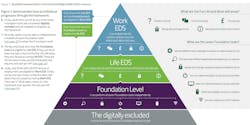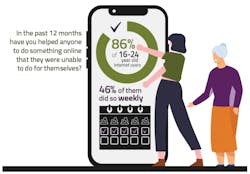Reducing Digital Exclusion in 2023
As things become increasingly digital, there’s a small proportion of the population losing their voice, access to services, and the ability to participate in our digital society.
Despite the United States and UK’s flourishing digital economy, we still have a way to go to ensure 100% access to our citizens. Internet access in the USA stood at 92% in early 2022. The UK has a slight advantage in reach with 96% of households being connected, according to the Office for National Statistics (ONS).
Unfortunately, many older generations are part of the 8% and 4% who are underserved in two of the most technologically sophisticated markets in the world. What’s more, the majority of the over-65 demographic are classified as “narrow” Internet users, which means they only use the Internet for a few activities and aren’t fully competent. This large portion of the older generation, some with little to no Internet access or experience, illustrates the worsening issue of digital inclusion in the UK and the US.
“…digital inclusion also refers to having the right digital skills and awareness to get connected. This includes the knowledge, confidence, and motivation to use the Internet.”
What is Digital Inclusion?
The impact of generational differences on digital inclusion rates is getting worse. It’s first important to define what it actually means before diving into the reasons why.
There are several facets that comprise what it means to be digitally included. On one hand there’s the physical inclusion, which refers to physical access to the Internet, be it through broadband, Wi-Fi, or mobile connectivity. It also means access to devices that enable Internet connections. A lack of access to devices and services could be due to many reasons, including affordability and a lack of assistive technology.
Often not discussed is the fact that digital inclusion means having the right digital skills and awareness to get connected. This includes the knowledge, confidence, and motivation to use the Internet.
All these issues disproportionately affect the older generation. According to Lloyds Bank’s Essential Digital Skills Report, despite 80% of people over 65 having access to the Internet, only 61% have the right foundational digital skills to leverage that connection. Think about the skills needed to connect to a Wi-Fi network, open an Internet application, log into an account, and trust it is secure. These examples highlight the fact that Internet accessibility doesn’t guarantee digital inclusion. (See Figure 1.)
It’s critical to understand why we should fight for generational digital inclusion. The Internet is a valuable tool that undeniably has a positive impact on people’s lives. It helps to alleviate loneliness and social isolation, improve the availability of jobs and education, and offers access to financial advice and government services.
With so many beneficial services appearing online, and some even going online-only, the Internet’s role in society is becoming more and more prevalent. This especially rings true in a post-COVID-19 society. Throughout lockdown, the Internet was as essential for practical tasks like banking, shopping, and finding information, as it was for communication and following hobbies and interests. And for 80% of people, it was a vital support system, according to the Good Things Foundation.
For many, it’s hard not to be online nowadays. Yet, those without access often find themselves relying on others to complete Internet-based tasks for them. This is known as proxy use. Ofcom reported that half of all non-users must ask someone else to do an Internet-based task for them. The most common requests were to make a purchase, access public services and healthcare. (See Figure 2.)
All these requests are essential, and not being able to do them will negatively impact a person’s quality of life. Take healthcare as an example. In the UK, over 40 million people visit the NHS website each month to get information, advice, and access services like appointment bookings and repeat prescriptions. As health information is increasingly digitalized, there’s a risk that older, Internet non-users will be excluded from these services, which will ultimately impact their well-being.
Fighting for Digital Inclusion
Digital inclusion of the older generation needs to be made a priority. The first step, of course, is getting them connected. That's why governmental infrastructure deployment plans are vital. In the UK, for example, there is an effort to deliver Gigabit-speed broadband nationwide by 2030.
The US also has aggressive plans under the IIJA’s Broadband Equity, Access, and Deployment (BEAD) Program. It provides $42.5 billion to expand high speed Internet access by funding planning, infrastructure deployment, and adoption across the US.
“…80% of people over 65 having access to the Internet, only 61% have the right foundational digital skills to leverage that connection. Think about the skills needed to connect to a Wi-Fi network, open an Internet application, log into an account, and trust it is secure. These examples highlight the fact that Internet accessibility doesn’t guarantee digital inclusion.”
While those are fine and good, there’s more to it than just access. Digital skills need to be addressed urgently. Every community needs a place people can go to get help with digital skills, from the very basics to the more advanced. Educating older people on the benefits of Internet access, and why it’s important to have a basic skill set, will be essential to the increasingly digital nature of our society.
In some ways, digital inclusion is becoming synonymous with social inclusion—ensuring that everyone, regardless of age, is guaranteed equality of opportunity. While there's no single, simple solution, boosting access and knowledge, digital tools will certainly help create a roadmap to reach this long-term goal.
REFERENCES AND NOTES
https://datareportal.com/reports/digital-2022-united-states-of-america
https://www.ons.gov.uk
https://www.lloydsbank.com/assets/media/pdfs/banking_with_us/whats-happening/211109-lloyds-essential-digital-skills-report-2021.pdf
https://www.goodthingsfoundation.org/good-things-foundation-newsletter/
https://www.ofcom.org.uk/__data/assets/pdf_file/0020/234362/adults-media-use-and-attitudes-report-2022.pdf
Defeating Gray Digital Daze
By ISE Staff
Shockingly, 22 million older people lack broadband access at home in the US, according to Aging Connected, an initiative to increase connectivity for older adults. Surprisingly, the District of Columbia, Minnesota, and Nebraska are the top three states that suffer from the greatest “broadband gap” between their underserved older citizens (65+) compared to those citizens between 18-64 years of age. (See Figure 1.)
Without access to the Internet, our country’s older adults are missing out on many digital life experiences. One simple example is healthcare. Today, doctor’s offices and government services are now switching to virtual or remote delivery. Seniors who need healthcare or receive aid may struggle to access these crucial resources.
Weforum.org says seniors need digital skills training, and the lack of it is one of the largest issues they face. With more of modern life being digitized, seniors may feel intimidated, frustrated, and even unsafe as they embark on their adventure in digital literacy. Try to empathize with a senior experiencing a website security protocol such as two-factor authentication. Alternately, a web interface that has a “hamburger menu” on the home page may be far from intuitive for someone who has never seen it before. These may seem like small things to digital natives, but they can be roadblocks for older adults trying their best to become digitally literate.
So how can we overcome these barriers and encourage digital inclusion for our seniors? As always, understanding starts with education. Five key barriers we must resolve are illustrated in Figure 2. Providing high-speed, low-cost Internet and devices, along with installation and support, is foundational for addressing connectedness. After getting connected, seniors need inclusive digital literacy programs that address some of the roadblocks mentioned above. Finally, people must have confidence that their privacy and personal data will be secure and ethically used or they will avoid using the new digital tools available to them.
REFERENCES AND NOTES
https://www.empowerline.org
https://www.weforum.org/agenda/2021/10/how-can-we-ensure-digital-inclusion-for-older-adults/
https://agingconnected.org/report/
About the Author
Sam Hales
Sales and Marketing Director, MS3 Networks
Sam Hales is Sales and Marketing Director at FTTP infrastructure provider MS3 Networks. He has more than 10 years of experience in marketing for fiber wholesales. For more information, email [email protected] or visit https://www.ms3networks.co.uk. Follow them on Twitter @MS3Comms, Facebook @MS3Networks, and LinkedIn: company/ms3-networks-limited.




